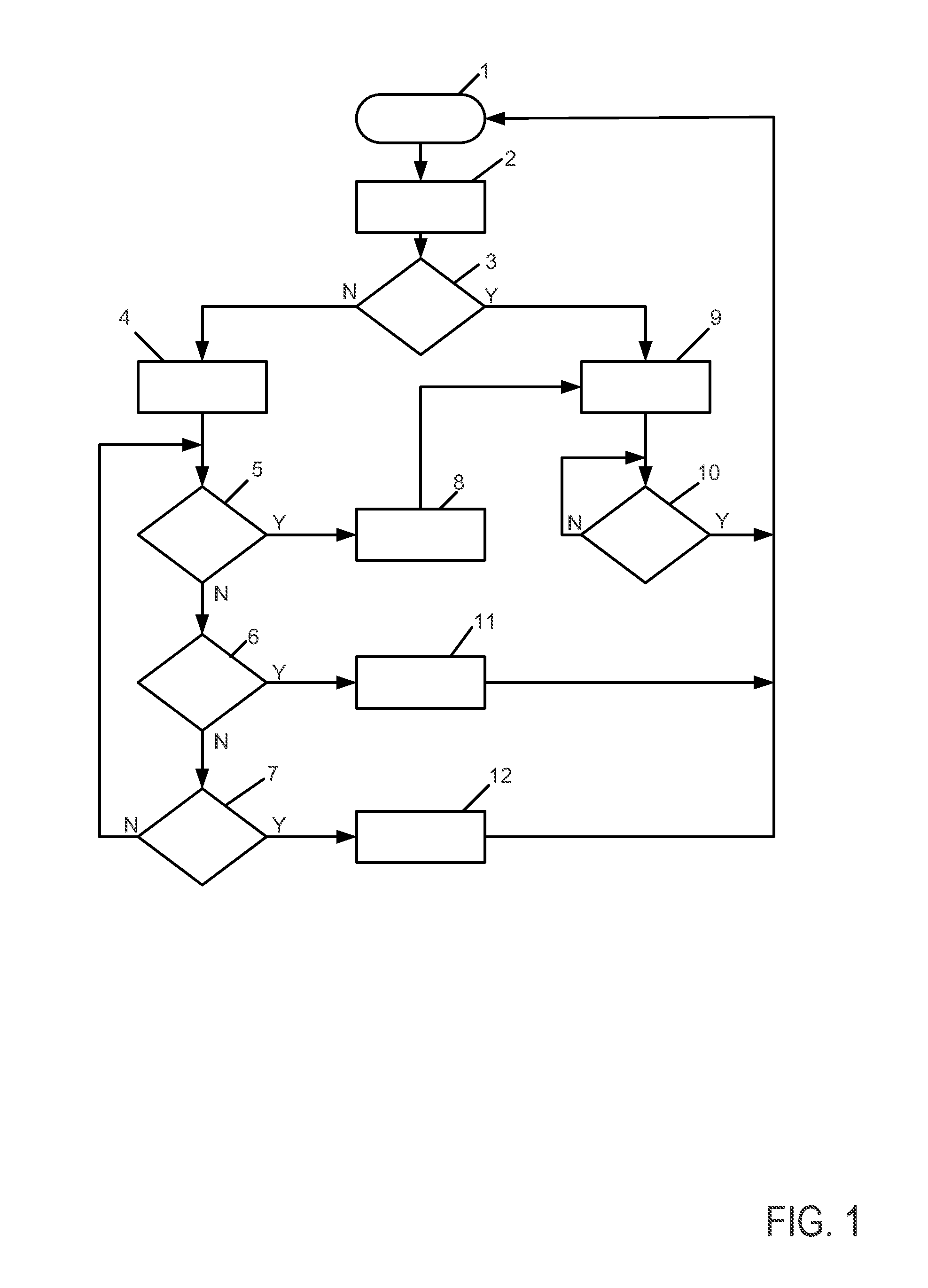[0017]The method can also be applied in motor vehicles with a
manual transmission to save energy (e.g., fuel) during the actual operation of the motor vehicle. Furthermore, there is an incentive for the driver to adapt his driving style to optimize the fuel consumption. As a result of the opening of the
drivetrain, braking systems are disconnected from the wheels with the result that the motor vehicle can continue to roll unimpeded, thereby saving energy.
[0018]The drivetrain can be opened when the driver releases the accelerator pedal or takes his or her foot off the accelerator pedal, and does not activate the
brake pedal. As a result, it is possible, as it were, to set the sensitivity of the method and provide an additional disengagement or opening threshold.
[0019]The state of the
clutch pedal, of the selected gear speed, of the speed of the vehicle, of the ambient temperature, of the positive gradient or of the negative gradient and / or of a trailer hitch can be detected. The states can be used to open or close the drivetrain and permit better
adaptation of the method to the motor vehicle. Further parameters such as charge state of the battery, the climate of the passenger compartment of the vehicle etc. can also be taken into account.
[0020]The drivetrain can be opened independently of the position of the
clutch pedal. This can take place by virtue of a further clutch which cannot be directly controlled by the driver, such as for example an electronic drive-by-wire clutch. After the drivetrain opens, the engine of the motor vehicle can be switched off, which leads to a further fuel saving.
[0004]Under certain circumstances it may be advantageous to save
kinetic energy in its present form instead of storing it. In the case of internal
combustion engines with an
automatic transmission there are possible ways of opening the drivetrain so that braking torques, such as are caused by the engine and possible kinetic
energy recovery systems, are reduced. This leads to a condition in which the vehicle is decelerated to a lesser degree and therefore continues to move forward.
[0021]The drivetrain can be closed so as to couple the engine to the wheels when the driver depresses the accelerator pedal or the
brake pedal and / or releases a previously depressed clutch pedal. A reliable
changeover is therefore brought about from the state of the opened drivetrain back to the
normal state with a closed drivetrain.
[0022]Depending on at least one of the detected states, it is possible firstly not to open the drivetrain but rather to close the
fuel supply to the engine. It is therefore possible, depending on the condition, to save energy without the drivetrain being directly opened if it is desired, for example, for reasons of comfort.
[0023]When the drivetrain is opened, it is possible to close the drivetrain and the
fuel supply to the engine depending on detection of activation of the
brake. This permits, when the state with an opened drivetrain ends, a return into an
intermediate state without a
fuel supply, which saves energy compared to the
normal state with an opened drivetrain and an opened fuel supply.
[0024]According to a second aspect of the description, a
control system for opening the drivetrain of a motor vehicle having a
manual transmission comprises a
signal input for receiving a status
signal from a
throttle function, and a clutch for opening the drivetrain when the
throttle function is not active. The drivetrain is opened by way of the clutch, that is to say the engine is disconnected from the wheels, as a result of which the motor vehicle as it were coasts along without requiring fuel and without masses or torques at the drivetrain braking the movement of the motor vehicle.
[0025]The
control system can comprise a
signal input for receiving a status signal from the brake function, wherein the clutch is opened when the brake function is not active and the
throttle function is not active. This takes into account not only the position of the accelerator pedal but also the position of the brake pedal, which permits finer observation of the driver's intention and can therefore make available a higher level of comfort.
[0026]The control
system for opening the drivetrain can comprise a control output which communicates with an engine of the motor vehicle, wherein, after the drivetrain opens, the motor is switched off by means of a
control signal via the control output. Energy can be additionally saved by switching off the engine. The control
system can, for example, be integrated into the engine controller but can also constitute a separate module or the control system is distributed among one or more already present modules such as, for example, the ABS control module or ESP module etc.
[0027]The control system for opening the drivetrain can comprise at least one sensor for detecting the state of the accelerator pedal, brake pedal, clutch pedal, selected gear speed, transmission
neutral position, of the speed of the vehicle, of the ambient temperature, of the gradient and / or of a trailer hitch. By means of the sensor signals, the control system can be adapted better to the motor vehicle and / or to the current conditions. Furthermore, safety functions and / or service functions can be additionally activated.
[0026]The control system for opening the drivetrain can comprise a control output which communicates with an engine of the motor vehicle, wherein, after the drivetrain opens, the motor is switched off by means of a
control signal via the control output. Energy can be additionally saved by switching off the engine. The control system can, for example, be integrated into the engine controller but can also constitute a separate module or the control system is distributed among one or more already present modules such as, for example, the ABS control module or ESP module etc.
 Login to View More
Login to View More  Login to View More
Login to View More 


